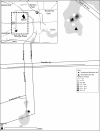Police Encounters Among Needle Exchange Clients in Baltimore: Drug Law Enforcement as a Structural Determinant of Health - PubMed (original) (raw)
Police Encounters Among Needle Exchange Clients in Baltimore: Drug Law Enforcement as a Structural Determinant of Health
Leo Beletsky et al. Am J Public Health. 2015 Sep.
Abstract
Objectives: We piloted a monitoring mechanism to document police encounters around programs targeting people who inject drugs (PWID), and assessed their demographic predictors at 2 Baltimore, Maryland, needle exchange program (NEP) sites.
Methods: In a brief survey, 308 clients quantified, characterized, and sited recent police encounters. Multivariate linear regression determined encounter predictors, and we used geocoordinate maps to illustrate clusters.
Results: Within the past 6 months, clients reported a median of 3 stops near NEP sites (interquartile range [IQR] = 0-7.5) and a median of 1 arrest in any location (IQR = 0-2). Three respondents reported police referral to the NEP. Being younger (P = .009), being male (P = .033), and making frequent NEP visits (P = .02) were associated with reported police stops. Among clients reporting arrest or citation for syringe possession, Whites were significantly less likely than non-Whites to report being en route to or from an NEP (P < .001). Reported encounters were clustered around NEPs.
Conclusions: Systematic surveillance of structural determinants of health for PWID proved feasible when integrated into service activities. Improved monitoring is critical to informing interventions to align policing with public health, especially among groups subject to disproportionate levels of drug law enforcement.
Figures
FIGURE 1—
Police encounter locations reported by needle exchange clients: Baltimore, MD, 2010–2012.
Similar articles
- Syringe access, syringe sharing, and police encounters among people who inject drugs in New York City: a community-level perspective.
Beletsky L, Heller D, Jenness SM, Neaigus A, Gelpi-Acosta C, Hagan H. Beletsky L, et al. Int J Drug Policy. 2014 Jan;25(1):105-11. doi: 10.1016/j.drugpo.2013.06.005. Epub 2013 Aug 2. Int J Drug Policy. 2014. PMID: 23916801 Free PMC article. - Barriers to using new needles encountered by rural Appalachian people who inject drugs: implications for needle exchange.
Davis SM, Kristjansson AL, Davidov D, Zullig K, Baus A, Fisher M. Davis SM, et al. Harm Reduct J. 2019 Apr 2;16(1):23. doi: 10.1186/s12954-019-0295-5. Harm Reduct J. 2019. PMID: 30940136 Free PMC article. - Examining the spatial distribution of law enforcement encounters among people who inject drugs after implementation of Mexico's drug policy reform.
Gaines TL, Beletsky L, Arredondo J, Werb D, Rangel G, Vera A, Brouwer K. Gaines TL, et al. J Urban Health. 2015 Apr;92(2):338-51. doi: 10.1007/s11524-014-9907-2. J Urban Health. 2015. PMID: 25300503 Free PMC article. - Tuberculosis, injecting drug use and integrated HIV-TB care: a review of the literature.
Grenfell P, Baptista Leite R, Garfein R, de Lussigny S, Platt L, Rhodes T. Grenfell P, et al. Drug Alcohol Depend. 2013 May 1;129(3):180-209. doi: 10.1016/j.drugalcdep.2012.11.013. Epub 2013 Jan 8. Drug Alcohol Depend. 2013. PMID: 23306095 Review. - The role of needle exchange programs in HIV prevention.
Vlahov D, Junge B. Vlahov D, et al. Public Health Rep. 1998 Jun;113 Suppl 1(Suppl 1):75-80. Public Health Rep. 1998. PMID: 9722812 Free PMC article. Review.
Cited by
- A police education programme to integrate occupational safety and HIV prevention: protocol for a modified stepped-wedge study design with parallel prospective cohorts to assess behavioural outcomes.
Strathdee SA, Arredondo J, Rocha T, Abramovitz D, Rolon ML, Patiño Mandujano E, Rangel MG, Olivarria HO, Gaines T, Patterson TL, Beletsky L. Strathdee SA, et al. BMJ Open. 2015 Aug 10;5(8):e008958. doi: 10.1136/bmjopen-2015-008958. BMJ Open. 2015. PMID: 26260350 Free PMC article. - Safe and unsafe spaces: Non-fatal overdose, arrest, and receptive syringe sharing among people who inject drugs in public and semi-public spaces in Baltimore City.
Hunter K, Park JN, Allen ST, Chaulk P, Frost T, Weir BW, Sherman SG. Hunter K, et al. Int J Drug Policy. 2018 Jul;57:25-31. doi: 10.1016/j.drugpo.2018.03.026. Epub 2018 Apr 13. Int J Drug Policy. 2018. PMID: 29660732 Free PMC article. - Enhancing drug checking services for supply monitoring: perspectives on implementation in syringe service programs in the USA.
Moon KJ, Whitehead HD, Trinh A, Hasenstab KA, Hayes KL, Stanley D, Carter B, Barclay R, Lieberman M, Nawaz S. Moon KJ, et al. Harm Reduct J. 2024 Jan 13;21(1):11. doi: 10.1186/s12954-023-00924-5. Harm Reduct J. 2024. PMID: 38218980 Free PMC article. Review. - Racialized environments and syringe services program implementation: County-level factors.
Bluthenthal RN, Humphrey JL, Strack CN, Wenger LD, LaKosky P, Patel SV, Kral AH, Lambdin B. Bluthenthal RN, et al. Drug Alcohol Depend. 2024 Oct 1;263:112430. doi: 10.1016/j.drugalcdep.2024.112430. Epub 2024 Aug 28. Drug Alcohol Depend. 2024. PMID: 39216198
References
- Taussig JA, Weinstein B, Burris S, Jones TS. Syringe laws and pharmacy regulations are structural constraints on HIV prevention in the US. AIDS. 2000;14(suppl 1):S47–S51. - PubMed
- Burris, S. Syringe possession laws map. Law Atlas: The Policy Surveillance Portal. 2015. Available at: http://lawatlas.org/query?dataset=paraphernalia-laws. Accessed June 30, 2015.
- Wodak A, Cooney A. Do needle syringe programs reduce HIV infection among injecting drug users: a comprehensive review of the international evidence Subst Use Misuse. 2006. 41(6):777–813. - PubMed
- Burris S. Syringe distribution laws map. Law Atlas: The Policy Surveillance Portal. 2014. Available at: http://lawatlas.org/query?dataset=syringe-policies-laws-regulating-non-r.... Accessed April 25, 2015.
Publication types
MeSH terms
LinkOut - more resources
Full Text Sources
Research Materials
Miscellaneous
